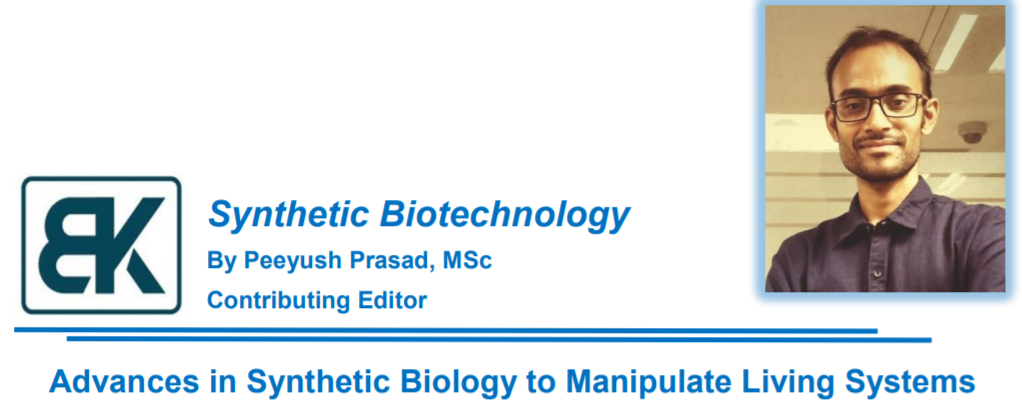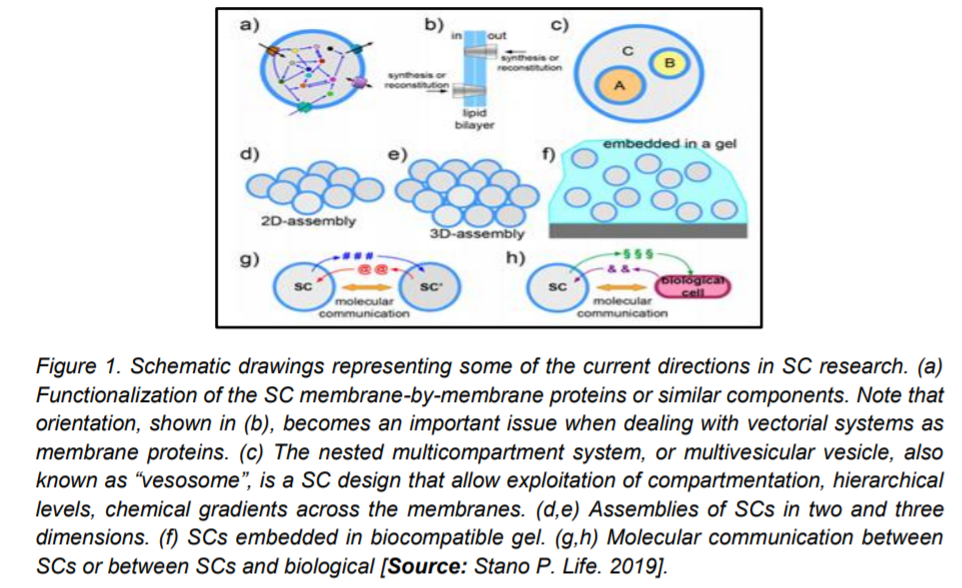
The Significance of Synthetic Biology in Living Systems
Imagine a future where you can create anything by manipulating living system and we will reach up to the idea of genetically modified organism. But how about creating new life forms for getting desired things such as life-saving cancer drugs, fuels, sensors, diagnostics, enzymes, storing data and electricity? Here, we are talking about synthetic life which started from few people’s bold attempt to understand what life is at its very basic level. Discovery of DNA to discovery of tools to manipulate DNA, we have come very far where we can precisely alter gene by using technology such as CRISPR-Cas9. Idea of synthetic life became reality when Craig Venter reported the design, synthesis and assembly of the 1.08- mega-base pair Mycoplasma mycoides JCVI-syn1.0 genome. Chemically synthesized genome was inserted into the M. capricolum and new M. mycoides was created. They called it synthetic cell as progeny cells contained the new set of proteins coded from transplanted genome
[1].
Further, several researches came into light that tried to create or manipulate the organism fundamentally for getting desired products. Synthetic life is usually designed by forward-engineering approach [2] that usually aims to create new molecular function. At the same time there is lack of consensus on what should be called as synthetic life. Is the synthetic life a total new creation of organism from scratch or is it just the alteration in the
organism for finding new molecular function such as production of artemisinin in yeast cells. In one of the research, team of scientists has introduced the gene which converts the FPP into artemisinic acid and inhibited the gene which converts the FPP in yeast into ergosterol for producing artemisinin. Artemisinin is produced by plant A. annua (sweet wormwood) [3, 4]. Artificial gene circuit can be used for finding cure for cancer such as development of gene circuits based on adaptive programming. Three components: a sensor for detecting inputs, a processor and an actuator which produces responses are integrated in artificial multigene circuits [5]. These circuits are based on transcriptional networks and regulators (Table 1).

Table 1: Companies working in the field of synthetic biology.
Reprogramming of Cells and Bacteria: An Example of Synthetic Biology in Cancer Cells
Cancer cells have multiple signatures and it is important that immune cells must be able to recognize the plethora of variations in the cancer cells for counter measures. Reprogramming of T-cells can be done so that it can recognize the different combination of antigens. For example, use of Synthetic
Notch (SynNotch) receptor T cell AND gate [6]. It has been observed that several bacteria specifically accumulate around the tumor therefore these bacteria can be manipulated for delivering specific therapeutics at tumor site [7]. In another study, researchers have developed the artificial version of E. coli (Syn61) present in stomach which can be used for the synthesis of drugs, catalysts, enzymes etc. In this case 4 million genetic code of Syn61 is synthesized from scratch [8]. Creating eukaryotic organism is another challenge due to complexity of its component. In one of initiative, group of scientists are trying to synthesize the yeast (SC 2.0) genome. The study will provide the information about genome organization, gene content and role of RNA in yeast biology [9]. Other than manipulating the molecular function inside cells, researchers is trying to create the cells from scratch. Synthetic cell consist of micro-compartments encapsulating biochemical molecules such as DNA, RNA, proteins, ribosomes, enzymes, ATP etc. These cells closely mimic the natural cells [10]. Figure 1 describes the direction of research currently going on in synthetic cell area.


The Future Prospects of Synthetic Biology
Development of new technology brings the question of ethics and safety. Autodesk which works in the field of software built its own virus (Phi-X174 bacteriophage). Genome of this virus consisted of 5,386 base pairs of nucleotides. This virus could infect E. coli but was not harmful for human [11].
But this kind of research often leaves us with the question of how far man can go into his endeavor to intervene with nature. At what point we need to stop and what are the long term consequences of these researches? Life which we see today is outcome of millions of years of evolutionary process where errors often get ample time to adjust in the evolving system but suddenly introducing new organism can be a shock to the system.
We have seen how genetically modified crop not only kills the pest against which it is developed but it also harms the other organisms. We are already struggling with multi antibiotic resistant infectious organisms and we have not yet found the drugs for many viral disease. Synthetic life has not yet found the place outside laboratory but accidental introduction of new organism in the outside nature can be very dangerous. Just imagine if synthetic virus as was created by Autodesk will exchange genetic material with other infectious agent. Therefore, it is important to outline guidelines. At the same time we can’t deny the fact that there is the need for new source of energy, medicine, agricultural products etc. and for this we need to invest in synthetic life research. Table 2 mentions the important products which can be derived from research on synthetic life. At research level, challenges are to design the living system from scratch. Understanding what sort of ingredient in what proportion will be required is yet to be explored in detail. Creating a lipid based membrane which can carry several molecules inside is still a very challenging task. Recently researchers used the microfluidics based approach for developing lipid bubbles which is similar to living cell membrane [12]. At last synthetic life research should not be driven by profit but by future need which cannot be solved by existing resource.
References
1. Gibson DG, Glass JI, Lartigue C et. al. Creation of a bacterial cell controlled by a chemically synthesized genome. Science. 2010 Jul 2;329 (5987):52-6. doi: 10.1126/science.
2. Slomovic S, Pardee K, Collins JJ et. al. Synthetic biology devices for in vitro and in vivo diagnostics. Proc Natl Acad Sci USA. 2015 Nov 24;112 (47):14429-35.
3. Paddon CJ, Keasling JD. Semi-synthetic artemisinin: a model for the use of synthetic biology in pharmaceutical development. Nat Rev Microbiol. 2014 May;12 (5):355-67.
4. https://cosmosmagazine.com/biology/life2-0-inside-the-synthetic-biologyrevolution
5. Benenson Y. Biomolecular computing systems: principles, progress and potential. Nat Rev Genet. 2012 Jun 12;13 (7):455-68.
6. Roybal KT, Rupp LJ, Morsut L et. al. Precision Tumor Recognition by T Cells With Combinatorial Antigen-Sensing Circuits. Cell. 2016 Feb 11;164 (4):770-9.
7. Wu MR, Jusiak B, Lu TK et. al. Engineering advanced cancer therapies with synthetic biology. Nat Rev Cancer. 2019 Apr;19
(4):187-195.
8.https://www.bbc.com/news/scienceenvironment-48297647
9. http://syntheticyeast.org/
10. Stano P. Is Research on “Synthetic Cells” Moving to the Next Level? Life (Basel). 2018 Dec 26;9(1). pii: E3
11.https://www.vox.com/2014/5/5/11626456/autodesk-builds-its-own-virus-as-thesoftware-giant-develops-design
12. https://www.nature.com/articles/d41586-018-07289-x